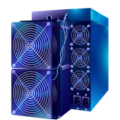MicroBT Whatsminer M21
Whatsminer M21 profitability insights powered by real-time data: Discover how much your Whatsminer M21 can earn using our advanced ASIC miner calculator. We use live mining reward data and automatically factor in electricity costs, giving you a clear overview of your potential daily, monthly, and yearly returns.
Profitability Analysis
Here you can see a detailed analysis of miner profitability, updated in real-time.
| Period | Income | Expense | Profit |
|---|---|---|---|
|
Daily
|
$1.40 | $3.57 |
$-2.17
|
|
Monthly
|
$42.04 | $107.14 |
$-65.10
|
|
Yearly
|
$511.44 | $1,303.49 |
$-792.05
|
About the MicroBT Whatsminer M21 (31TH/s)
Learn more about this ASIC miner, including its specifications, performance, energy consumption, and profitability.
The MicroBT Whatsminer M21 arrives like a precise instrument forged for the alchemy of SHA-256, offering a steady 31 TH/s while drawing about 1860 W from the grid and achieving roughly 0.06 J/GH, a balance of brute hashing and economical energy draw that makes it attractive to solo hobbyists and professional rack operators alike; built-in power supply and robust thermal management simplify installation and lower the barrier to entry, while its ASIC architecture is tailored to mine Bitcoin and allied coins sharing the SHA-256 family-Bitcoin Cash, Bitcoin SV, Namecoin, Ecash, Fractal Bitcoin and Peercoin-so operators can pivot across chains as conditions dictate. In practical terms the M21 rewards careful site planning: reliable mains, ventilation, rack space and monitoring for temperature and uptime will protect hashing continuity and ROI, and using pooled mining, firmware updates and quality cooling will maximize long-term performance. To translate raw hashes into operational decisions, a comprehensive profit calculator that models your hashrate, current network difficulty, block rewards and pool fees alongside electricity consumption and local rates will produce daily, monthly and annual yield projections to help compare setups, optimize energy strategies and decide whether to scale, diversify coin targets, or focus on efficiency improvements that tilt marginal gains into consistent advantage.
Discover Which Coins This Miner Can Mine
Explore the cryptocurrencies that can be mined using MicroBT Whatsminer M21 (31TH/s), including detailed profitability.
Currency Converter
Calculate the mineable coins to any currency.
| Coin | Income/Day | Profit/Day |
|---|---|---|
|
$1.31
$
0.00001289

|
$-2.26
$
-0.00002220

|
|
|
$1.30
$
0.00001286

|
$-2.27
$
-0.00002241

|
|
|
$1.28
$
0.00253466

|
$-2.29
$
-0.00455161

|
|
|
$1.40
$
3.49

|
$-2.17
$
-5.41136060

|
Historical Mining Performance
View the performance trends of MicroBT Whatsminer M21 (31TH/s) over weekly, monthly, and yearly timeframes.
Historical Profitability
View the historical income and profit trends for this miner.
SHA-256 Miner Generations
Evolution of cryptocurrency mining hardware throughout the years, with the current generation highlighted for reference.
Generation 1
26 minersGeneration 2
26 minersGeneration 3
26 minersGeneration 4
26 minersGeneration 5
26 minersGeneration 6
26 minersGeneration 7
27 minersGeneration 8
27 minersGeneration 1
26 minersGeneration 2
26 minersGeneration 3
26 minersGeneration 4
26 minersGeneration 5
26 minersGeneration 6
26 minersGeneration 7
27 minersGeneration 8
27 minersMore Information about the
Learn more about the MicroBT Whatsminer M21 (31TH/s)
The MicroBT WhatsMiner M21 is a purpose-built SHA-256 ASIC that produces a steady 31 TH/s while drawing roughly 1860 W and delivering about 0.06 J/GH, positioning it as a high-throughput, energy-aware choice for mining Bitcoin and SHA-256 siblings such as Bitcoin Cash, Bitcoin SV, Namecoin, Ecash, Fractal Bitcoin and Peercoin; its 12 nm ASIC core, dual high-speed fans and aluminum-alloy shell form a compact thermal-management package, while the integrated power supply simplifies cabling at the cost of demanding a stable incoming feed, and firmware that allows voltage tuning alongside automatic thermal throttling gives experienced operators the levers to tune efficiency versus reliability. Operationally this combination implies clear site requirements: disciplined electrical provisioning and surge protection or conditioning to prevent brownouts, structured airflow and rack spacing to avoid heat recirculation, acoustic mitigation where noise matters, and a maintenance cadence that anticipates fan replacement and PSU health-treat spare parts and firmware rollbacks as inventory items rather than afterthoughts. From a systems-strategy perspective, maximize long-term output by combining pooled mining for steadier revenue, proactive firmware updates that close vulnerabilities and refine power curves, and continuous monitoring of hash rate, temperature and uptime so that automated alerts can trigger rapid intervention; use a profitability model that integrates your measured hashrate, current network difficulty, block rewards, pool fees and actual measured power draw to produce daily, monthly and annual projections and run sensitivity analyses against difficulty shifts and utility rate changes to determine break-even horizons and whether to scale, diversify coin targets, or invest in efficiency upgrades. Consider also site-level optimizations such as grouping units to enable waste-heat capture, negotiating power delivery terms to lower effective energy cost per terahash, and planning for decommissioning or resale paths as network economics evolve. Above the metrics and checklists, treat the miner as a body at the threshold between life and silence: every watt sustains its work, every compromised connection risks the void, and the disciplined interplay of cooling, power stability and operational governance is what separates resilient, long-term hash production from intermittent, costly downtime.
Where to Buy?
Trusted vendors and current market availability, showcasing verified suppliers offering this ASIC miner along with their latest pricing and stock information.
No Offers Available
There are currently no offers for this miner. Please check back later.
Technical Specifications
Detailed hardware specifications and mining capabilities for MicroBT Whatsminer M21
Basic Information
Performance
Physical Dimensions
Mineable Cryptocurrencies



Algorithm Information: SHA-256
Learn more about the SHA-256 algorithm and how it works.
SHA-256 is a cryptographic hash function that serves as the backbone of Fractal Bitcoin proof-of-work consensus mechanism. This algorithm processes input data of any length and produces a fixed hash value, ensuring security and integrity in the mining process.
Crypto Mining Pools
Connect to the most reliable mining pools and maximize your crypto mining efficiency with optimized uptime and profitability.
User Reviews
See what users are saying about this miner.
No Reviews Yet
Be the first to review this miner!
Frequently Asked Questions
Everything you need to know about the MicroBT Whatsminer M21
How efficient is the MicroBT Whatsminer M21 31TH/s?
What are the electricity costs for the MicroBT Whatsminer M21 31TH/s (USD)?
How much power does the MicroBT Whatsminer M21 31TH/s use?
Who manufactures the Whatsminer M21?
What is the hashrate of the MicroBT Whatsminer M21?
Which cryptocurrencies can be mined with the MicroBT Whatsminer M21 31TH/s?
 NiceHash (BTC)
NiceHash (BTC)
 Bitcoin (BTC)
Bitcoin (BTC)
 Bitcoin Cash (BCH)
Bitcoin Cash (BCH)
 Fractal Bitcoin (FB)
Fractal Bitcoin (FB)
 English
English
 German
German
 Hungarian
Hungarian
 Dutch
Dutch
 Spanish
Spanish
 French
French
 Italian
Italian
 Czech
Czech
 Polish
Polish
 Greek
Greek
















